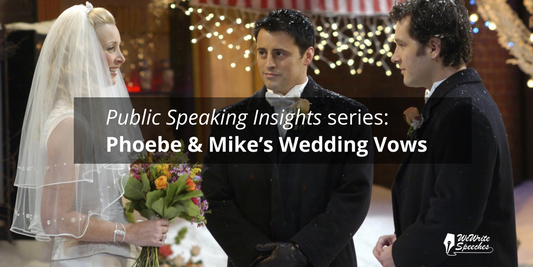Are you a seasoned pro at delivering work presentations, yet the thought of giving a wedding speech, a birthday toast, or a eulogy makes you break into a cold sweat?
You're not alone.
Contrary to popular belief, the skills needed for social speeches, like those at weddings, can be vastly different from those needed for professional presentations. Here are a few reasons why even proficient speakers might find themselves facing unexpected challenges when it comes to crafting and delivering that heartfelt wedding toast:
-
Different Audiences, Different Dynamics: You often present to a familiar audience with shared knowledge and interests at work. However, you face a diverse crowd of all ages and backgrounds at a wedding, birthday party, or funeral. Navigating these varied dynamics can be daunting.
-
The Emotional Rollercoaster: While work presentations focus on facts and figures, social speeches require a personal touch. Expressing deep emotions and sentiments in front of an audience can be intimidating, especially for those accustomed to more formal settings.
-
Mastering the Microphone: Unlike the controlled boardroom environment where a microphone might be stationary or built into a podium, social speakers (especially at weddings or birthdays) often wield a hand-held microphone. For those unaccustomed to this setup, handling a microphone while delivering a speech can add an unexpected layer of complexity.
-
No Slides, No Problem: In the corporate world, presentations often rely on visual aids like slides to convey information. However, the focus is squarely on the speaker and their words at a social event. Even if a projector is available, its usage differs vastly from the typical corporate setting, requiring adaptability and creativity from the speaker.
-
Balancing Information and Entertainment: While informing or persuading might be an objective in a professional context, social speeches are expected to captivate and entertain. Striking the right balance between heart-on-your-sleeve sincerity and engaging content is no easy feat.
-
Sharing Personal Stories: Wedding speeches often involve sharing personal anecdotes, for example, about the groom in a best man speech or about the deceased in a eulogy. For some, this level of intimacy can be uncomfortable, particularly if they're more reserved by nature.
-
The Comedy Conundrum: Injecting humor into a speech requires finesse; not everyone has a natural knack for it. While humor might be sparingly used in the workplace, it's often a cornerstone of successful wedding toasts, especially the best man speech (and is frequently used, even in eulogies).
-
Navigating Unfamiliar Territory: Work presentations typically follow a structured format, whereas wedding speeches can be more fluid and less formal (or at least can appear to be so). Adapting to this unfamiliar format can throw even the most seasoned speakers off their game.
-
Confronting Public Speaking Anxiety: Despite excelling in professional settings, many individuals grapple with a fear of public speaking, which can be amplified in more personal, emotionally charged situations like weddings.
-
The Weight of Emotional Stakes: While flubbing a work presentation might result in professional consequences, messing up a wedding speech feels infinitely more personal. The audience may also be several times bigger than many in the professional environment are used to. The heightened emotional stakes can lead to added pressure.
-
The One-Shot Deal: Unlike work presentations that can be refined and repeated, a wedding speech is a one-time affair. Even if you are given a father-of-the-bride speech and have several daughters, the pressure to get it right on the first try can be overwhelming.
- Practice Makes Perfect: Even the most polished presenters, who don’t usually need to practice their talks, may lack experience delivering social speeches. The problem occurs when they overestimate their readiness because of their comfort as corporate speakers. Even seasoned speakers can stumble without sufficient practice in the social style of speaking.




